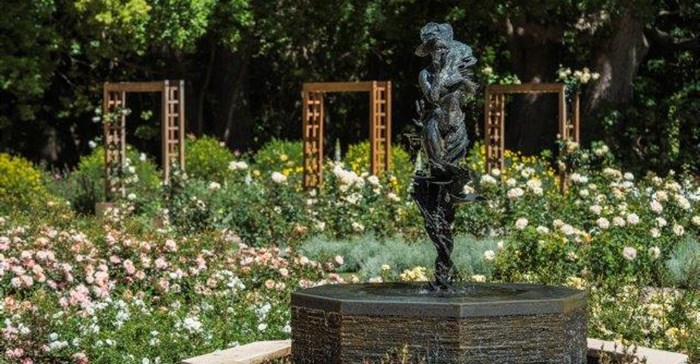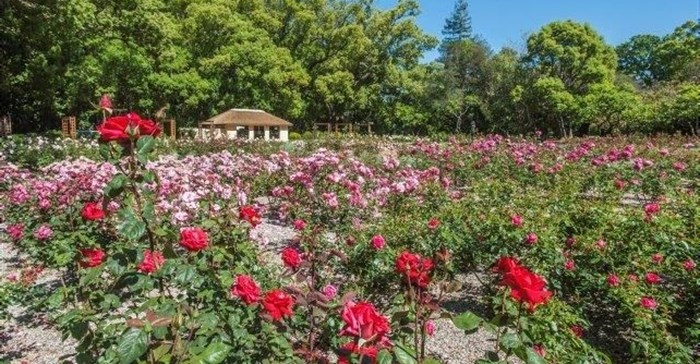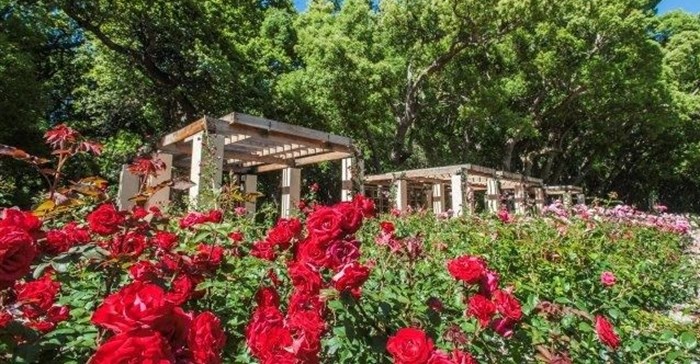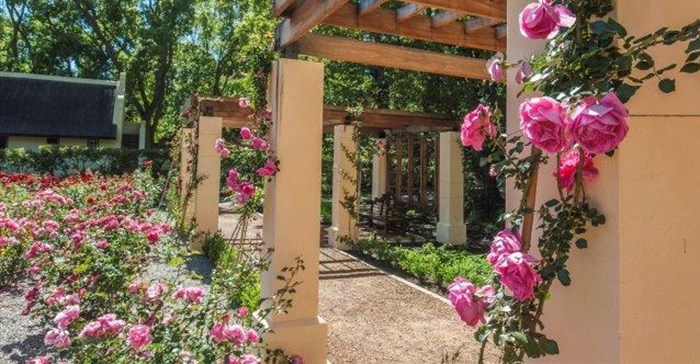Following a massive horticultural undertaking involving 1,200 tonnes of virgin soil, 90 tonnes of peach pips, 40 tonnes of compost and 1,500 new roses, 316-year-old wine estate, Vergelegen's freshest attraction this summer is a world-class rose garden with over 80 different rose varieties on display.
The extensive collection of blooms – many specially chosen for their glorious scent, as well as beautiful appearance – spans miniature roses to rambling climbers, heritage blooms and newly-bred hybrids that can be viewed by the public for the first time.
The new garden has been designed in Vergelegen’s trademark octagonal shape, with a colour palette that transitions from reds, oranges, and yellows to whites on the right and from purples, deep and light pinks to white on the left.

Stanislaw Trzebinski Aphrodite sculpture
Its central feature is a bronze sculpture of a woman entitled Aphrodite (the Greek goddess of love and beauty), created by Kenyan-born artist Stanislaw Trzebinski. Water cascades from the sculpture into an octagonal pool of water. “We wanted to stimulate the sight, scent and hearing senses immediately and for visitors to enjoy a feeling of discovery,” said Vergelegen horticulturist Richard Arm, who was closely involved in the project from inception, with particular responsibility for the landscaping and irrigation.
The rose garden is ideally located at the edge of a camphor tree forest, forming a magnificent amphitheater to the south and west of the site. To the north, there is a view to the homestead and its five enormous camphor trees, declared national monuments in 1942.
A cottage-style herbaceous border of heritage roses, indigenous bulbs, foxgloves and other perennials frames the estate’s picnic building at the far end. Persimmon and avocado trees and a hedgerow complete the exquisite surroundings.
Heritage roses
Vergelegen MD Don Tooth said that soon after Anglo American purchased the estate in 1987, a team was commissioned to restore the gardens and grounds in the historic core. The same approach of layered historicism that had been followed in restoring the buildings and interiors (reflecting the influences of previous owners) was adopted for the gardens as well.
“The rose garden planted at that time (on the site of the former tennis court) was still being admired nearly 30 years later. It was, however, no longer blooming to its full potential, nor did it match the investment we made several years ago in new hospitality buildings and gardens.” Vergelegen accordingly consulted OVP Associates, which had designed the East Garden near the new Stables restaurant several years previously.
The brief was to create a superb rose garden on the existing site, on par with Vergelegen’s extensive portfolio of cultivated gardens, to enchant both novices and rose cultivators alike. Work began in August 2015.
Digging down
“We designed the new rose garden to inhabit the full space available and to respond to its unique and strikingly beautiful setting and historic context,” said Johan van Papendorp, director of OVP Associates. “It was important for the garden to be as captivating when viewed on arrival, as looking at each bloom up close. It was also vital that the garden read as one cohesive layout and not as a ‘Smartie box’ of heights and colours.”
The formal geometry of the octagon, which has a long history as a spatial informant at Vergelegen, was the starting point for the layout. The extensive operation involved digging down into and removing the top metre of soil (and old galvanised metal pipes discovered underground). The selection and layout of the roses were made in association with Ludwig Taschner and Marie Favard of Ludwig’s Roses, who supplied the plants. Taschner’s rose-growing recipe of agricultural lime, fertiliser, and other ingredients was used to prepare the fresh soil brought in on a digger loader.
The rose varieties were carefully selected and their placement designed to provide a gradient of colour and height, from the smallest miniatures in the centre to the tall spires and scramblers on the outskirts, where the garden meets the camphor forest beyond. The result? A garden that is both striking and cohesive.
All the irrigation is hidden – there are no unsightly stand-pipes to distract the eye. Long pop-up sprays give the roses a soft soaking in the early mornings, imitating nature. The system allows various sections to receive different amounts of water for their particular requirements. A crushed peach pip mulch, first tested out on the East Garden agapanthus planting, also helps to retain moisture.
Inspired by mythology
Concentric and diagonal pathways form routes through the rose garden so that visitors can meander and experience a wide array of varieties, and get up close to appreciate their individual colours and fragrances.
Pergolas provide a structured backdrop to the rose garden, as well as support for the outer layer of tall, scrambling and climbing roses. The pergolas cover the outer rose garden pathways and provide areas to pause and appreciate the view across the garden. The design detailing is a variation of a pergola designed by OVP for the estate’s East Garden.
“The ‘Vergelegen yellow’ masonry pillars and rhythm of heavy overhead timber beams speak to the exposed ceiling beams within the homestead and to the language of architecture across the estate,” said van Papendorp.
Trzebinski, the creator of the beautiful central feature, said his inspiration came from Greek mythology. “Aphrodite was born from sea foam. As she emerged onto the seashore, the foam falling off her body sprouted into the first white roses as it landed on the sand. “Some of the organic forms of the sculpture hint at the connection with the rose itself, with petal-like shapes growing off Aphrodite’s shoulders, head, and thigh. The purpose of these formations is not only to mimic that of the rose but also to give this sculpture movement and a sense of fluidity.”
“It now feels as if the garden has always been here,” said Arm. “It appeals to all ages. It is not only delighting expert rose growers, but also children, who love exploring and deciding what bloom is their favourite. And I think we’re going to have many marriage proposals here too.”
































